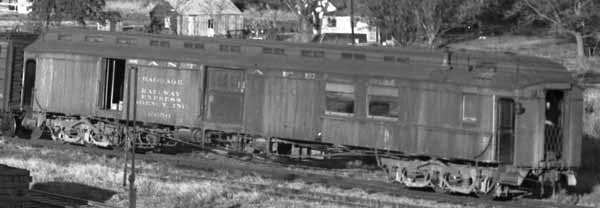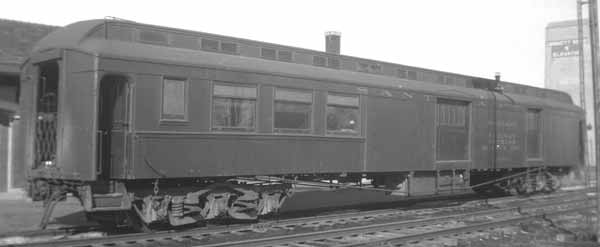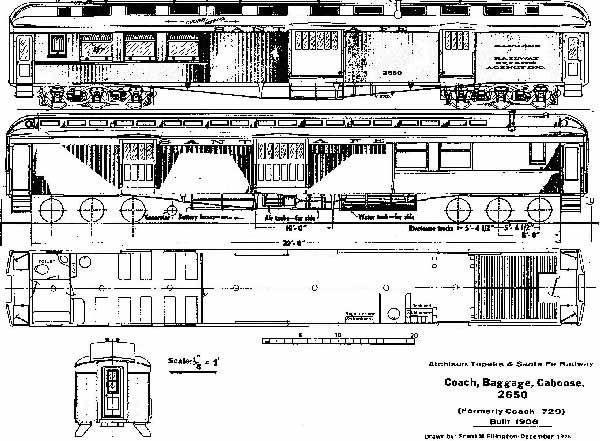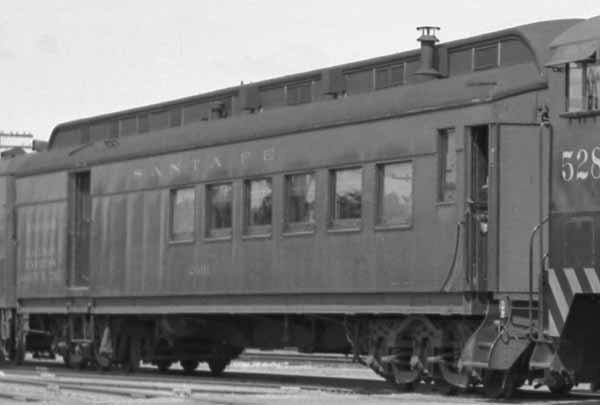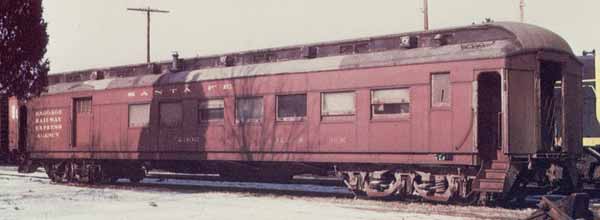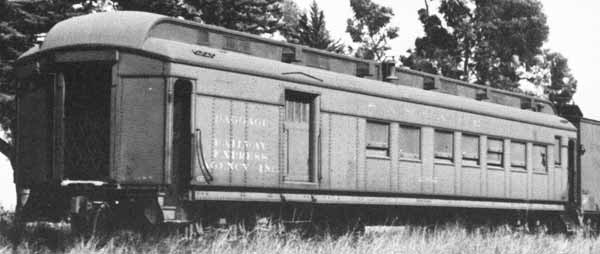Howard
Branch: Consists: Combines | ||||
| The Howard Branch trains were mixed trains until 1960. This page will focus on the combines specifically mentioned by James Burke as operating on the Howard Branch circa 1950. Unless otherwise stated, the photos come from Burke. From the early date 95/96 were two different trains, one originating in Emporia and one in Moline. Two combines were needed to cover this mixed service. 2535 and 2650 were these combines in the mid 40s. The 2650 ran its first revenue on the Howard on February 6, 1946. On December 15, 1948, the new timetable went into effect with one train making the roundtrip each day instead of two trains. One engine would go down and back, but coaches were swapped at Moline, so two combines remained in service. On January 22, 1949, the 2535 was heavily damaged in a wreck at Severy. It was replaced by 2301 so that 2301 and 2650 continued the service. The 2301 and 2650 ran their last run on January 19, 1950. The 2601 replaced them January 21, 1950. James Burke reports that all of these combines were coach green. He believes that all the combos on the eastern lines (east of Newton) were green while the western lines were brown in the 40s. He remembers brown combines at Harper in 1947 or 48. He did not see a mineral brown coach on the branch until he returned from the army in 1955, and it was all brown after that. John Moore reports In a listing of passenger equipment 211-17 dated 10-1923 has a listing for Combination Cars in Coach Baggage Service and Coach and Caboose Service. Colors are referred to as Freight and Passenger. The Freight color was used on cars equipped with Cast Iron Wheels and the Passenger color was used on cars equipped with Steel Tires. (why not steel wheels ? - seems like the other passenger equipment had them). McCall's CC&C states that the first series of cars connverted to "Coach & Way" service (2300s) were painted mineral brown with white lettering. This became "more-or-less" standard for Santa Fe mixed train equipment. Prior to 1920, the 2400 and 2500 series cars moved to the freight accounts were painted mineral brown and their steel wheels exchanged for iron freight wheels. They also gave up their signal lines, diaphrams, electric light and steam heat (if any). The second generation of cars had iron wheels installed and were also painted mineral brown with white lettering. These replaced old cars in the 2300-2500 series. Within this second generation, some cars retained their passenger green paint, diaphrams, electric lighting, steam heat, in almost a random fashion. In the 30s, the green cars tended to be concentrated in the 2500 and 2600 number blocks. As time passed, attrition and accident caused vacancies in these numbers. Surviving cars in the 2400-2600 series tended to undergo renumbering back to the 2300 series and if renumbered cars were originally green, they tended to remain so when renumbered to the lower series. As the second generation overlapped the first, so the third generation overlapped the second. Drover conversions 2310-14 received mineral brown paint and went to mixed service. 2309 and 2315-20 were painted green and used as wartime rider cars for the mail trains. During the winter of 1946-47, they were repainted as mineral brown mixed train combines. 2622-43 were rebuilt 1950-53 and given mineral brown paint. A group of green cars in the 2542-48 series became surplus for passenger service in the late 50s and were moved to mix train service. 2410-15 were the last cars produced (1956-57) and were also mineral brown. See below for a list of known car colors. Click here for a survey of commercially available HO scale models. Click here for a survey of commercially available N scale models 2650
Drawing by Frank Ellington (with second side by Steve Sandifer) from Caboose Cars of the Santa Fe, second edition. Click on the drawing for a larger image. The 2650 started life as Pullman lot 3301 in 1906. It was wooden coach 729 and was converted to coach, baggage and caboose in August, 1929. It appears that the 2650 ran on the Howard Branch from February 6, 1946 to January 19, 1950. After its years of service, John McCall reported that the car body was seen on the ground at Emporia for a while and Frank Ellington measured and drew it at that location. 2601
2601 was Pullman lot 4023 built in 1912. It also had a 70' body. It was constructed as steel underframe Coach and Mail #44. These had a 30' mail room. It became coach, baggage and Caboose 2601 in November of 1931 with the side plated and the RPO windows covered. It lasted in service until July, 1959, when it was sold. The first run on the Howard branch was January 21, 1950. It served some time prior to that in motor trailer service for the M157 between Chanute and Kansas City. This car had a vestibule in one end only. An article on these Smoker-Mail Cars is in the Santa Fe Modeler 4:3, May/June 1981, p. 10+.
A number of the Pullman 4023 cars were rebuilt into combines. Below are some photos of these cars from John McCall's, Coach, Cabbage & Caboose. None are exact duplicates of the 2601, but they should give the modeler some ideas. Cars from this lot include: 2098, 2383, 2384, 2643, 2644, 2645, 2656, 2647, and 2649.
2535 The 2535 was built in 1904 as Pullman lot 3038, 72' Buffet-library 1309, San Francisco. It was converted to combine service in June, 1925. It was part of the 2530-2543 series. Click here for a floor plan of the 2532-2537 series conversions. The 2535 was wrecked at Severy in January, 1949, and not seen on the Howard branch again. Note the lack of the Santa Fe sill. We are seeking photos of 2532-2537 cars.
2301 The 2301 replaced the 2535 on the Howard in January, 1949. It only ran on the branch for year before the one of the trains was discontinued. In the mid 50s it became MOW 198932 and was destroyed in February, 1958. It was delivered in 1910 with a steel underframe and the distinctive ATSF sill along the bottom of the car as smoker 867 in Pullman lot 3778. It became coach, baggage & caboose in October, 1939. It had a wood body and was sheathed with steel plates in the thirties. Here for a floor plan of sister car 2300. Photos from the Society Chair Car book show 2302, 2303, and 2306.
| ||||
